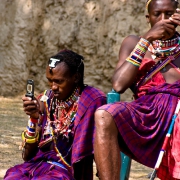More Technologies, Same Social Inequalities
Since the Arab Spring uprisings, human rights activists worldwide have championed the power of technology, mainly the Internet and mobile phones, as tools for democracy and change. Evidence shows that they are right, social media played a role in bringing down dictatorships in the Middle East and North Africa. But other evidence shows that technology actually often reinforces social inequalities in other instances, giving more voice to the powerful, further drowning out the meek cries of the politically weak.
Social media has been successful when all social classes unite to take down the big bad evil dictators. The Arab Spring is the contemporary poster boy for this movement. The proletariat united, rose up, and took down the bourgeois in Tunisia and Egypt, and is still fighting in Syria, Libya, and other nations. Twitter hashtags and facebook groups were large players in mobilizing protestors, who came from all backgrounds—rich, middle-class, and poor—and simply communicated with their mobile phones to organize mass movements.
It seems logical, then, to assume that social media and technology penetration will lead to more democracy and social justice. The more blackberries in a country, the less the economic disparity. The more rural telecenters, the less political corruption. Or at least so goes the thinking.
Studies show otherwise. To the extent that inequalities between social classes are affected at all by the increase in ICT usage, they often became stronger and disparity increases. In a DFID study in 2005 on telephone use in India (Gujarat), Mozambique, and Tanzania, researchers found the most wealthy and educated people used phones more and with greater frequency, in both urban and rural areas. Other studies show that not only do more educated and wealthier people have greater access to ICTs, they also value them more, and use their for more development related activities as opposed to entertainment than poorer populations. Furthermore, the rich and smart are far more likely to produce digital content, solidifying the stronghold of the elite in societal knowledge production.
The relationship between ICT penetration and social inequalities, then, is more complex than the Arab Spring would suggest. The difference with the Arab Spring is that the people united to take down one leader, whereas daily life features far more social classes and political opinions, halting social change, or at least considerably slowing it down. While technology helped bring social justice to entire nations, it did not eliminate social classes within the nations.
In order to decrease social inequalities in ICT usage, then, ICT designers and national policymakers should consider stipulations to favor usage of their technology by marginalized social classes. Whether it be reducing costs to allow poorer classes to buy the product or developing voice recognition technology to engage the illiterate, extra effort will be needed to reduce the social inequality of ICT usage. Preliminary efforts by USAID’s Women in Development initiative show promise; other agencies should mimic their efforts to increase ICT usage among digital minority populations. Without these extra efforts to assist marginalized populations, ICTs will only further embed developing nations with social and economic inequalities, leading to future instability and lower quality of life.








































